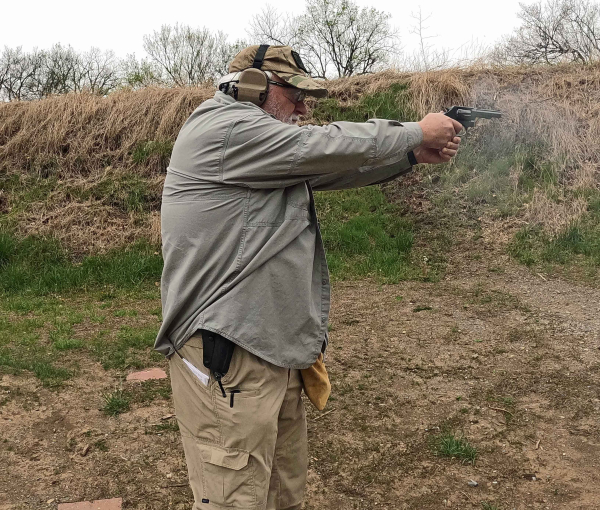Using the May Drill of the Month from Rangemaster, seen here, I elected to run the S&W M10-14, a revolver we looked at last year.
This drill involves firing 30 rounds, in various exercises, but in each stage the time limit is 4 seconds, hence the name.
The target is a B-8, B-8C, or FBI IP-1 bullseye target, scored as printed. If a full-size B-8 is used, hits further out than the 7 ring are counted as misses. 300 points possible. – If you’re new to holster skills, (1) don’t go fast, go for sure; (2) don’t try catching a fumbled gun, let it go to the ground; (3) make sure the mouth of the holster is clear of obstructions, gear and keep your index finger straight and away from the trigger when reholstering.
The course of fire follows -
3 yards Start holstered. On the beep draw and fire 6 rounds.
5 yards Start holstered. On signal, draw and fire 5 rounds. Do this stage 2 times.
5 yards Start at Ready, gun in dominant hand, pointed at the ground below the target. On signal, fire 4 rounds using the dominant hand only.
5 yards Start gun in non-dominant hand only, at the Ready, pointed at the ground beneath the target. On signal, fire 3 rounds, non-dominant hand only.
7 yards Start holstered. On the beep, draw and fire 4 rounds.
10 yards Start holstered. On the beep, draw and fire 3 rounds.
Why with a revolver? I shot it the first time with a modern striker fired pistol (albeit of the micro-compact variety; if you’re going to shoot these drills, it helps to use something like the guns you actually carry). The shorter (and lighter) trigger stroke, the self-feeding action – these are considered faster than the 1899-designed round gun.
The sole change to the revolver was removing the classic-looking Magna wood stocks and installing the Hogue Bantam 62000; synthetic with an open backstrap, finger grooves and a long enough front to provide a rest for the small finger, I found these to be great for the round-butt K-frame revolver.

The Four Second Standards covers lots of ground in 30 rounds, including shooting one-handed and one-handed with nondominant hand.
I drew from concealment – and I didn’t go over time on one-handed stages, though the control could have been better. I shot the course with remanufactured ammo featuring cast 158gr SWC bullets.
For the first string, 6 rounds from concealment at three yards, I got the hits out in 3.82 seconds, measured by the Shooters Global timer. All six hits went into the “10” ring, not great shooting but okay.
The black-on-black sights against the bullseye made for some tough going, wrecking my times and not enhancing the accuracy.
I pushed one into the 9-ring when shooting dominant hand only at five yards and pushed a pair of rounds out of the “10” at seven yards. I ended by “failing,” going over time at seven-and-10 yards.
I didn’t get out-run by the clock until I got further back. That was less trigger and more the lost sights, with no contrast between front- and rear sights and the black bullseye.
I continued and scored the target. Removing a pair of “10s,” I ended with 264/300. The old-style gun didn’t fail me, but my vision didn’t help me.
To slow myself down some, I shot the FBI Instructor bullseye course, another 30 rounds of ammo. Still hampered by the sights – and having seen that a six o’clock hold was a problem for point of impact (though not for visibility), I still gave it a go.
The course involves a pair of five-round strings at 25 yards, slow fire. The pair of five-shot strings for timed fire (15 seconds per), followed by rapid fire (10 seconds each), are shot at fifteen yards.
I ended with 281/300. That’s good enough to enter instructor school – and to stay in during the mid-class bullseye test.
A good revolver can still seal the deal – if the shooter can.
— Rich Grassi